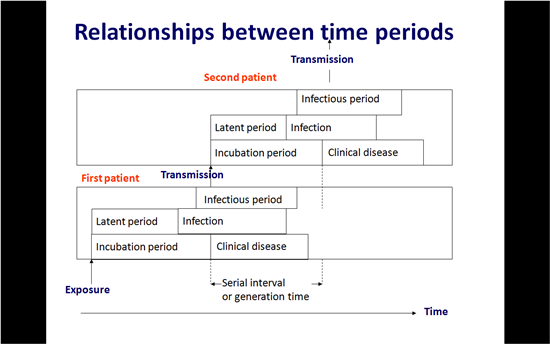Incubation period, Latent period and Generation time: Difference between revisions
Bosmana fem (talk | contribs) (Created page with " Category:Refining the estimated point in time of an outbreak source") |
Bosmana fem (talk | contribs) mNo edit summary |
||
| Line 1: | Line 1: | ||
A specific characteristic of infectious disease epidemiology is the definition of the different stages of infection according to time. | |||
The starting point is the moment when a pathogen enters the host: this moment is often referred to as the 'exposure moment'. Immediately after this moment, the pathogen usually will move to the preferred tissue or target organ. This will be the place within the host where the pathogen can effectively multiply. Different pathogens may have different target organs. Hepatitis virus will target the liver for multiplication, for example, while Legionella will target the lungs. | |||
In the next stage, the pathogen will multiply, and the host immune system will start a response. This is the start of the infectious process, where cellular and humoral host defences will be activated. Though this process may not yet be visible through clinical symptoms, there will be signs that can be observed through laboratory diagnostics (such as increased sedimentation rate, or shift in the distribution of white blood cells). At this stage, we may speak of 'an infection' (which may be symptomatic or asymptomatic). | |||
The period between exposure and infection is called the 'latent period' since the pathogen is present in a 'latent' stage, without clinical symptoms or signs of infection in the host. | |||
The period between exposure and onset of clinical symptoms is called the 'incubation period'. | |||
The host may become infectious (i.e. able to transmit the pathogen to other hosts) at any moment of the infection. This moment will vary per pathogen. | |||
The following schematic figure demonstrates these different time periods: | |||
[[File:4454.Incubation.png-550x0.png|1200px|frameless|center]] | |||
When one person transmits an infection to another, then the time that elapses between onset of symptoms in the primary case and onset of symptoms of the secondary case is called 'generation time', referring to the time it takes for the first group of patients to 'generate' the next group. | |||
<div style="display: inline-block; width: 25%; vertical-align: top; border: 1px solid #000; background-color: #d7effc; padding: 10px; margin: 5px;"> | |||
'''FEM PAGE CONTRIBUTORS 2007''' | |||
;Editor | |||
:Arnold Bosman | |||
;Original author | |||
:Arnold Bosman | |||
</div> | |||
[[Category:Refining the estimated point in time of an outbreak source]] | [[Category:Refining the estimated point in time of an outbreak source]] | ||
Latest revision as of 20:44, 16 April 2023
A specific characteristic of infectious disease epidemiology is the definition of the different stages of infection according to time.
The starting point is the moment when a pathogen enters the host: this moment is often referred to as the 'exposure moment'. Immediately after this moment, the pathogen usually will move to the preferred tissue or target organ. This will be the place within the host where the pathogen can effectively multiply. Different pathogens may have different target organs. Hepatitis virus will target the liver for multiplication, for example, while Legionella will target the lungs.
In the next stage, the pathogen will multiply, and the host immune system will start a response. This is the start of the infectious process, where cellular and humoral host defences will be activated. Though this process may not yet be visible through clinical symptoms, there will be signs that can be observed through laboratory diagnostics (such as increased sedimentation rate, or shift in the distribution of white blood cells). At this stage, we may speak of 'an infection' (which may be symptomatic or asymptomatic).
The period between exposure and infection is called the 'latent period' since the pathogen is present in a 'latent' stage, without clinical symptoms or signs of infection in the host.
The period between exposure and onset of clinical symptoms is called the 'incubation period'.
The host may become infectious (i.e. able to transmit the pathogen to other hosts) at any moment of the infection. This moment will vary per pathogen.
The following schematic figure demonstrates these different time periods:
When one person transmits an infection to another, then the time that elapses between onset of symptoms in the primary case and onset of symptoms of the secondary case is called 'generation time', referring to the time it takes for the first group of patients to 'generate' the next group.
FEM PAGE CONTRIBUTORS 2007
- Editor
- Arnold Bosman
- Original author
- Arnold Bosman
